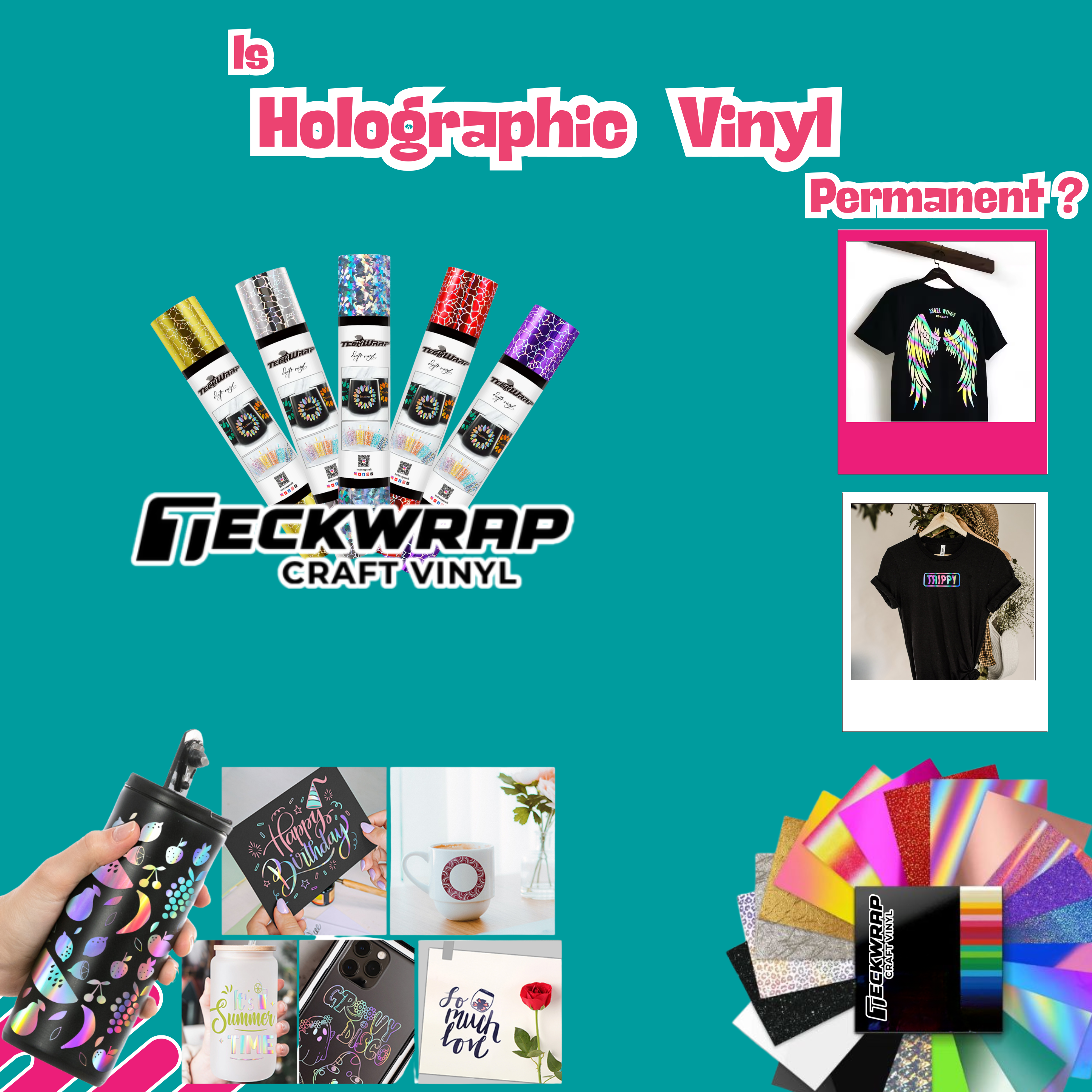Posted By TeckWrap Craft On July 14, 2023
How To Use Heat Transfer Vinyl?

Table Of Contents
- Understanding Heat Transfer Vinyl
- Tools Required To Use Heat Transfer Vinyl
- Step-By Step Process Of Using Heat Transfer Vinyl
- Step 1: Fabric Preparation
- Step 2: Design Your Cut File
- Step 3: Load The Vinyl
- Step 4: Do A Test Cut
- Step 5: Cut And Weed The Design
- Step 6: Apply The Design
- Applying HTV With Iron
- What Problems Can You Face When Using Heat Transfer Vinyl?
- HTV Not Adhering Properly
- HTV Wrinkling Or Bubbling
- Cutting Issues When Using HTV
- Design Alignment Issues
- Care Instructions After Using Heat Press Vinyl
- Where To Use Heat Transfer Vinyl?
- Frequently Asked Questions
Heat Transfer Vinyl (HTV) is a versatile material that allows you to create custom designs on various compatible fabrics and surfaces. Whether you are a DIY enthusiast or a business owner looking to add personalized touches to your products, understanding how to use heat transfer vinyl is essential. In this comprehensive guide, we will present the step-by-step process of using HTV to create stunning designs that will make your projects stand out.
Understandinag Heat Transfer Vinyl
Heat transfer vinyl, also known as iron-on vinyl, is a thin, flexible material that adheres to compatible fabrics such as cotton, polyester and poly/cotton blends, and other soft surfaces using sufficient time, heat and pressure. It has a heat activated adhesive backing that forms a strong bond with the substrate giving a long lasting performance.

HTV comes in a wide range of colors, finishes, and textures, allowing for endless creative possibilities. Before you begin working with it, familiarize yourself with the types available, such as glossy, matte, glitter, metallic, and so on, to determine which suits your project best.
Tools Required To Use Heat Transfer Vinyl
To get started with HTV, you will need a few essential tools. These will make your job easier and you will be able to achieve perfection. Here’s what you need:
- Premium quality heat transfer vinyl: In order to ensure durability of your crafts, it is important to get the best heat transfer vinyl film such as the one available at TeckWrap Craft. Whether you are adorning your t-shirt or pillowcase, do not compromise on the quality.
- Heat press or iron: A heat press provides consistent heat and pressure, yielding better results. However, an iron can work as well, especially for smaller projects.
- Cutting machine or scissors: A cutting machine, such as Cricut or Silhouette, is ideal for precise cuts, but you can also use scissors if you have a steady hand and your HTV design is not that complex.
- Cutting mat: This is required for accurate automated cutting of the vinyl. It ensures that the surface underneath is not damaged by the blades of your machine. At TeckWrap Craft, we have cutting mats with grids that help in the correct sizing and placement of the vinyl when it is loaded in the machine.
- Weeding tools: You will be needing these to help you remove excess vinyl from the design if you have used a machine to cut your design. At TeckWrap Craft, we have the excellent quality tweezer, weeder and weeding pens. You can use either of these to make your job easier and hassle-free.
- Parchment paper or Teflon sheet: You will need this to place on your design during heat application so that the vinyl is not damaged due to excessive heat and pressure.
Step-By Step Process Of Using Heat Transfer Vinyl
The best heat transfer vinyl for cotton garments should adhere seamlessly and withstand the rigors of everyday wear. The HTV at TeckWrap Craft is engineered with exceptional adhesive properties, guaranteeing a secure bond between the vinyl and the fabric. It resists peeling, cracking, and fading, allowing your designs to endure the test of time without compromising their visual appeal.
Step 1: Fabric Preparation
Before you transfer your design to your project, prepare the fabric on which you wish to apply HTV by washing and drying it beforehand. Do this especially if you are using 100% cotton since it tends to shrink and this might distort the design later on.
This will not only pre-shrink the garment but also remove any chemicals from it that may hinder strong adhesion. Do not use bleach or fabric softener during this pre-wash. Once the fabric is dry, press to remove any excess moisture and residual chemicals.

Step 2: Design Your Cut File
This is preparing the design on the software that comes with your cutting machine. If you use Cricut, the free software you will get with it is Design Space, and with Silhouette, you get Silhouette Studio. If you think these softwares have limited capabilities in terms of fonts and designs, you can also work in Procreate, Adobe Illustrator, Inkscape, Canva, CorelDRAW and others but these might not come free.
All these programs are user-friendly and if you are not well-versed in them, you can easily learn through online tutorials. However, you will have to buy these to use their full features. Once you have decided on the design you will use, it’s time to set its dimensions according to the space on your fabric where you want to place it.

Measure your item that you want to put the design on such as a shirt or a t-shirt, and adjust your settings on the program to ensure correct size. If you are putting text on your fabric, recheck the spelling and format of the fonts. Once it is cut, there is no going back and you will have to use more vinyl to apply corrections and cut again.
One of the most important facts that you must take care of before you send your design to the automated cutter is to make sure that your image is mirrored (reversed horizontally). This is because the backside of the heat transfer vinyl is cut and when you press it, it faces the correct way.
Step 3: Load The Vinyl
Once your design is final, you will have to load the vinyl onto the automated cutter. Cut a square piece of vinyl bigger than your design from all sides and place it on the cutting mat. Your heat transfer vinyl will have a shiny and a dull side. The shiny side is the carrier sheet which keeps the HTV pieces together in their right place when transferring onto a substrate.

The dull side is the adhesive which will face up when you are loading the vinyl. Hence you are cutting on the adhesive side. Another important point is to make sure your cutter has the right settings for the particular heat transfer vinyl you are using. Different HTVs on the market have varying thicknesses, you will want to adjust your cut settings accordingly.
TeckWrap Craft provides setting instructions with the vinyl package. You will have to follow these because if you use too much force, you can end up cutting through the plastic carrier. With too little force you won't be able to properly weed away excess vinyl.
Step 4: Do A Test Cut
A test cut is important to avoid wasting the vinyl and to be sure that you are using the right cut settings. Cut a small piece of vinyl into a small square or triangle. Though this might seem like an unnecessary effort, it will save you a lot of money and hassle in the long run especially if you are new to heat transfer vinyl usage.
Step 5: Cut And Weed The Design
Once the mat with the vinyl is loaded and your design is ready, it is time to cut it. Let the machine do its work. When it is done cutting, unload the vinyl and take out the negative pieces from the design using a tweezer. weeder or a weeding tool, whatever you are comfortable with.

Start by peeling the excess vinyl from around the design by hand. Once the bigger pieces are out of the way, weed out the small intricate pieces from within the design until you have the final one ready. If your pattern is really complex, it always helps to keep a printout handy so you may readily know from where you have to take out the vinyl.
Step 6: Apply The Design
Preheat your heat press or iron to the appropriate temperature recommended for the specific HTV you are using. Refer to the manufacturer's instructions for temperature guidelines. Load your fabric onto the bottom platen of your heat press. If you are using EasyPress, keep the fabric on a firm table. Place your design where you want it to be. Align it correctly because once it's transferred, there is no going back. This time the glossy part, which is the carrier sheet, will be facing upwards.
Cover the design with a parchment paper or Teflon sheet and apply the recommended heat and pressure for the specific time. These guidelines are also provided with the vinyl you are using. For example, for the PU Heat Press Vinyl at TeckWrap Craft, the temperature required is 266℉ to 284℉ for 8 to 12 seconds. You can also refer to our heat press temperature guide for details.

Once the recommended time has elapsed, remove your heating source. Wait for the carrier sheet to cool down a bit before carefully peeling it off, starting from one corner. If any part of the design starts to lift, do not panic. Place the carrier sheet back down and reapply heat and pressure for a few more seconds.
Keep in mind that using a heat press machine is generally preferred for applying HTV as it provides more consistent heat and pressure. However, with proper technique and care, you can achieve satisfactory results using a household dry iron as well.
Applying HTV With Iron
Put parchment paper on top of the design and press down on your iron applying pressure to all parts of your design. Do this for about 10-20 seconds. You might have to adjust time as some heat transfer vinyl films take longer to adhere. Do not move the iron to and fro. Make sure each part of the design gets proper heat and pressure.
Once the time is up, remove the carrier sheet a bit to see if the vinyl has adhered to the fabric. If it comes up with the carrier, place it back and apply more heat and pressure for strong adhesion. If your iron has holes underneath, lift and place it at different spots on the design so that the whole of it gets heat and pressure. Once your design has transferred, you are ready to behold your amazing creation!
Ironing HTV design onto the fabric is very easy as well. Make sure you have placed your fabric on a hard and firm surface since you will be applying pressure. Do not put it on an ironing board. Plug in your iron on cotton setting. Make sure its dry iron without steam or the steam function is turned off.
Put parchment paper on top of the design and press down on your iron applying pressure to all parts of your design. Do this for about 10-20 seconds. You might have to adjust time as some heat transfer vinyl films take longer to adhere. Do not move the iron to and fro. Make sure each part of the design gets proper heat and pressure.
What Problems Can You Face When Using Heat Transfer Vinyl?
Sometimes, during the application of heat transfer vinyl, several challenges or problems may arise. Mentioned below are some of the most common issues that may occur and how you can resolve them:
HTV Not Adhering Properly
Certain factors can cause improper adhesion of the HTV, like insufficient heat or pressure, improper temperature settings, inadequate pressing time, or incompatible fabric. To ensure that you are using the recommended temperature and pressing time for the specific HTV you are working with, adjust the pressure or increase the pressing time if needed. Double-check that your heat press or iron is reaching the desired temperature.

It is also highly recommended to pre-wash and pre-heat the fabric you are working with to improve adhesion. Furthermore, avoid using high heat when laundering the garment and follow the recommended care instructions for the specific HTV and fabric combination.
HTV Wrinkling Or Bubbling
Bubbles are formed on the HTV due to uneven heat distribution during application or mishandling in any form. To avoid these make sure you are applying consistent pressure and heat across the entire design. Be assured that you are using the recommended heat, pressure and time settings.
You may also smooth out HTV carefully during application to minimize wrinkles or bubbles. If you notice any unevenness after applying the vinyl, you can try using a Teflon sheet with moderate heat to reapply pressure and flatten the vinyl.
Cutting Issues When Using HTV
If you are having problems in cutting the vinyl, it might be because either the vinyl hasn’t been inserted correctly into the machine, or the right cutting force has not been used, or there is some issue with your blades and they need to be changed. Blades lose their sharpness as they get old so you need to replace them for better performance.

Design Alignment Issues
Before you transfer your design onto the fabric, measure and mark the desired spot to avoid misplacement. This will ensure that it is not misaligned and when you wear the garment, it is just at the right place. To avoid improper sizing or centering of the design, use alignment guides or marks on your heat press or ironing board to ensure accuracy. Practice can help you overcome these challenges.
Care Instructions After Using Heat Press Vinyl
After applying heat press vinyl on a fabric, you have to take care of it to ensure its longevity. Mentioned below are the care instructions that you need to follow to get the most out of your craft:
Instructions For Washing
- Do not wash the garment or wear it for at least 24 to 48 hours. This is to allow the heat transfer vinyl design to cure and set.AudioVolumeMuteAudioVolumeMute
- Turn the garment inside out before washing.
- Wash the garment with hands in cold or warm water, depending on the fabric's care instructions. Avoid machine wash.
- Do not rub the garment together especially where you have the heat transfer vinyl design.
- Avoid using harsh detergents, bleach or fabric softeners as they can damage the HTV.
- If possible, avoid washing the garment with items that have zippers, hooks, or other abrasive elements.
- Do not dry clean the garment as the harsh temperature and solvent based solutions that are used during dry clean might damage the HTV design.
Guidelines For Drying and Ironing
- Do not tumble dry as excessive heat from the dryer can cause the HTV to peel or crack.
- Hang the garment to air dry on a clothesline whenever possible.
- Do not hang the garment with HTV in sunlight.
- Iron the shirt inside out. Avoid applying too much heat on the design.
- nother way is to cover the HTV design with parchment paper or a cotton cloth and set the iron to low temperature.
- Do not use the steam function of the iron.
Where To Use Heat Transfer Vinyl?
As we know that heat transfer vinyl is applied to fabrics and is compatible with cotton, polyester and their blends, there are many heat transfer vinyl project ideas that you can employ. Here’s how you can use this vinyl:
- HTV is extensively used to create personalized designs on garments such as t-shirts, hoodies, hats, and bags. It allows individuals and businesses to add unique graphics, names, numbers, logos, and intricate patterns to their clothing.
- It is a preferred choice for creating professional-looking sports jerseys and team uniforms. It enables the application of player names, numbers, team and sponsor logos with precision and durability.
- Many businesses and organizations use HTV to brand and customize promotional products such as caps, bags, jackets, and shirts. It allows for cost-effective mass customization, making them ideal giveaways on events and marketing campaigns.
- Heat transfer vinyl offers endless possibilities for creating personalized gifts. It can be used to customize items made with compatible fabrics. HTV allows for adding names, initials, quotes, and designs to make the gifts more meaningful and unique. You can apply these on a piece of fabric and get it framed to make an exquisite wall hanging. You can also make custom shirts or tote bags to give them as a gift.
- HTV is also used for decorating various home items, including pillows, blankets, towels, aprons, and tablecloths. It allows individuals to create custom designs that match their interior decor style or to add personalized touches to gift items for special occasions.
- It can also be used in the fashion industry to create unique designs and accents on clothing, shoes, handbags, headbands, bandannas and other accessories. It enables designers to experiment with intricate patterns, textures, and finishes, adding a touch of exclusivity to their creations.
Frequently Asked Questions
Unleash Your Creativity With Heat Transfer Vinyl!
At TeckWrap Craft, we are dedicated to providing the best heat transfer vinyl for cotton garments, offering unmatched quality, exceptional performance, and boundless creative possibilities. Elevate your custom cotton projects to new heights with our superior HTV collection. Experience the difference that quality makes and transform your cotton garments into stunning and alluring masterpieces.
Remember to experiment, practice and have fun with your projects in order to create stunning and unique designs with heat transfer vinyl. Buy the exquisite, supreme quality HTV rolls in your favorite colors and finishes from TeckWrap Craft and impress everyone with your crafting skills!





